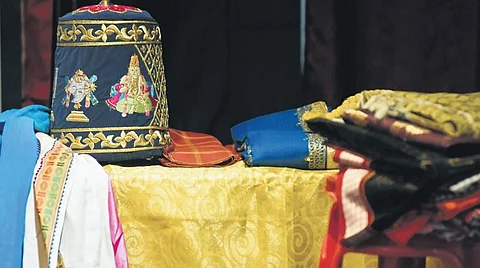

CHENNAI: The sanctity of textiles is something common to many an ancient civilisation, remarked Madhusudhanan Kalaichelvan, architect and heritage enthusiast, at ‘Sacred Textiles’, a talk held at Arkay Convention Centre, Mylapore, on Sunday, with inputs from Sreemathy K, founder of Sthree Creatives, a handloom boutique store.
Most traditional civilisations attribute auspiciousness to life’s important stages — birth, puberty, marriage, death etc., and each stage is marked with religious rituals that call for the use of fabric in some form. More often than not, the fabrics themselves acquire a special importance, Madhusudhanan explained as he walked the audience through a number of examples of sanctity accorded to certain textile traditions surrounding temple rituals in Tamil Nadu.
Incorruptible elements
“Silk and gold being considered the purest elements by virtue of the fact that they can’t be contaminated by contact with other materials, it is customary that silk clothing or gold ornaments be worn during religious ceremonies,” said Madhusudhanan. He drew attention to one of the rituals practised in Tamil Nadu’s temples focussed on purification, called pavithra utsavam. “Temples have rituals and festivals all around the year, and the priests ensure that their sanctity and spiritual purity are maintained. In order to wash off any impurities, a festival of three to nine days called pavithra utsavam or cleansing festival is held,” he said. If something impure enters the altar during this festival, the deities are adorned with the pavithra maalai maalai meaning garland and pavithram meaning pure. Strands of silk are woven together into a garland, and the same is done with cotton dipped in turmeric.
It’s not only the deities even the vessels used for the ritual and the temple gopuram are adorned with the garland. Every movable and immovable object in the temple, right down to the priest, is made to wear this garland. When the ritual happens to be a procession, even the processional vehicle is adorned with the pavithra maalai. “Vaishnavite temples in Tamil Nadu are steeped in traditional rituals. The agamas demand that one takes care of the deity like they do their own child,” added Madhusudhanan.
A shrine devoted to Krishna at Mannargudi depicts him holding a whip in his right hand and his left hand placed on a cow. Traditionally, a cowherd is allowed to wear only one piece of cloth. But temple traditions also demand that the deity should have a crown that covers his head. The head, being the fountainhead of all energy, should remain concealed, so they came up with a solution, which was to drape the deity all over in a single piece of cloth tied around his waist and take it all the way to his head, where it is wound into a turban, hence giving him the name ‘Ekavastradhari’.
Checkered history
Ranganathaswami, the deity at Srirangam temple, offers a rather interesting story. He is clothed in an exclusively-made red coloured fabric with yellow checks during the ritual bath. While any clothing other than white is forbidden inside temples, this deity is draped in what is essentially a kaili or lungi, a type of clothing that arrived with the first Muslim settlements in the country. Narrating the legend behind this, Madhusudhanan said,
“The deity was taken to Delhi during the Delhi Sultanate’s invasions, where the Sultan Alauddin Khilji’s daughter fell in love with it and would adorn it with her favourite clothes. When the priests from Srirangam visited the Sultan and requested that the idol be returned, the Sultan waited for his daughter to fall asleep so that he could return the deity safely to the priests. When the daughter woke up and realised her beloved deity had been taken away from her, the Sultan sent her accompanied by an army to Srirangam. When she reached there and realised the deity is not there yet, she fell down and died.”
A shrine in the second circumambulatory path is thus devoted to her, and the belief is that till date, the Ranganathaswami deity has roti and dal for breakfast and some of it is offered to the daughter’s shrine. The kaili worn by the deity is now exclusively made by a family of weavers in Uraiyur, Tiruchy district.
At the end of the talk, Madhusudhanan was felicitated by Sreemathy with a special gift from Sthree Creatives.